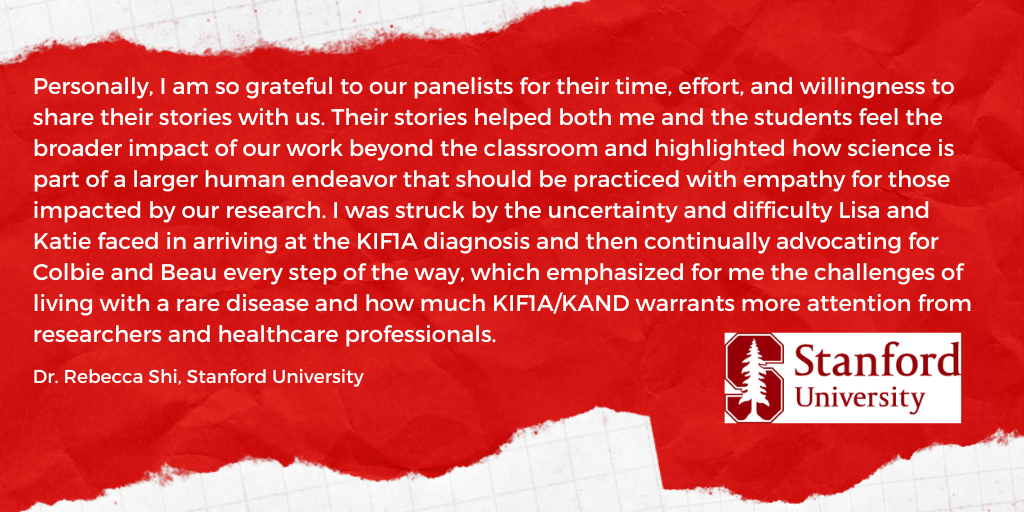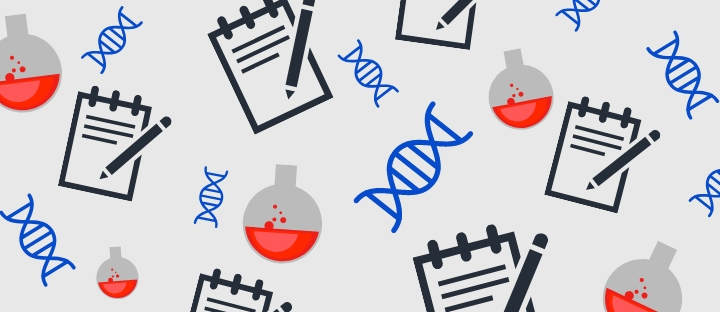What do worms, a classroom full of students, and members of the KAND family community have in common? A lot more than you’d think! In this blog post, KIF1A.ORG Chief Science Officer Dr. Dominique Lessard describes a unique cross disciplinary experience with multiple scientific stakeholders in the rare disease space, all focused around our holistic understanding of KAND.
How do we move the needle to make patient voices and experiences the center of scientific discovery? There are many ways to answer this question, focused around different entities or stakeholders involved in the scientific discovery process.
One approach is to target common entities in the therapeutic development process such as regulatory agencies, established clinicians, and biopharmaceutical companies. The approach often focuses the patient-voice around a common goal of treatment, be it to inform a clinical endpoint or identify patient demographics for a drug treatment.
Another, perhaps less common approach, is to integrate patients into the venue where some of the first seeds of scientific discovery are planted: the classroom. Introducing young scientific minds to the rare space, and teaching them to value the patient voice, can shift the culture of science and medicine to better serve vulnerable communities. It’s an investment in the long-term success of rare disease research, even if it doesn’t provide an immediate clinical on-ramp.
A New Opportunity: the KIF1A Research Network in Action
KIF1A.ORG was presented with such an opportunity by teaming up with Dr. Rebecca Shi of Stanford University, who worked to create a research laboratory course for undergraduates in the Stanford Biology department for the Spring 2023 semester.
The story of how we became connected with Dr. Shi is a shining example of the KIF1A Research Network in action. Inspired by the KIF1A work of Dr. Shinsuke Niwa, a longstanding KIF1A Research Network member, Dr. Shi reached out to our clinical champion Dr. Wendy Chung to inquire more about KIF1A Associated Neurological Disorder. Dr. Chung introduced us to Dr. Shi, leading us to some very exciting news: Dr. Shi would be the first investigator to design an entire undergraduate research-based course around KAND!
This series of interactions highlights the importance of creating and organizing multi-stakeholder research networks centered around one or many rare diseases and disorders. By investing in organizational capacity, with significant impact via the Chan Zuckerberg Initiative Rare As One Project, KIF1A.ORG has been able to grow our research network from 16 to 160 individuals in under 3 years time. In doing so we have had many notable achievements and successes, including unique opportunities to bring multiple KAND stakeholders together in the same project/goal.
What Can We Learn From A Worm?
The class led by Dr. Shi was designed to introduce and engage students in the process of scientific research and inquiry. For many students of this academic level, it might be the first opportunity to perform guided research with immediate disease-state context as an end goal. In doing so, this class gave students the opportunity to explore what it means to “do science” and “think like a scientist”.
“You will engage in many of the activities and thought processes that professional scientists use; for example, you will evaluate scientific arguments; make discoveries by generating, testing, and revising hypotheses; communicate findings to others through oral and poster presentations; and build confidence in yourselves as scientific thinkers.”
From Stanford University BIO43 Course Syllabus
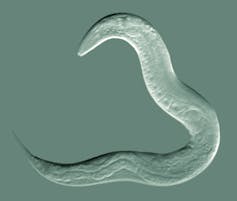
To study KAND, students used a model organism, defined as non-human species that are used in the laboratory to help scientists understand biological processes or diseases. Regarding rare disease therapeutic development, we commonly hear reference to “mouse models” that are used to represent human disease, test novel therapeutic ideas, and inform us on how safe and effective therapeutic compounds are in a biological organism. However, students in Dr. Shi’s class turned to a different, but equally intriguing, model system – worms!?
Yes, worms. The worm model organism utilized in this course is known as Caenorhabditis elegans, or C. elegans for short. C. elegans are tiny worms that live in soil and are commonly used as model organisms in research. What makes these worms useful in scientific research? Importantly, the genetics and nervous system have been very well characterized which allows researchers to answer specific neurogenetic research questions. Furthermore, they are a relatively easy system to perform genetic editing, like introducing a mutation into a specific gene to see its effect on the worm’s behavior and biological systems. Finally, like humans, C. elegans worms have a version of KIF1A called unc-104, which has a significant amount of similarity to the human KIF1A.
The central scientific goal for this class was to “[conduct] authentic research that studies the consequences of disease-related mutations in a neuronal kinesin (KIF1A), by using behavioral, genetic, and cell biological tools to assay how KIF1A mutations affect C. elegans neurons”. In other words, students will learn:
- How to set up experiments using C. elegans worms with genetically introduced KIF1A mutations
- How to quantitatively assess the effect of introduced KIF1A mutations
- How to uncover connections between the structural changes of UNC-104/KIF1A mutations and how they impact function
- How to synthesize, represent, report, and present scientific findings
It goes without saying that KIF1A.ORG was thrilled about this opportunity to engage with Dr. Shi and her students. True to our central ethos at KIF1A.ORG, we knew there were many ways in which we could help provide KAND-specific context and awareness to these eager students.
Patient Perspectives Driving Scientific Inquiry
In planning this course, Dr. Shi and Dr. Lessard worked together to discuss the many ways in which KIF1A- and KAND-specific content could be woven into the goals of the students’ projects. First, they identified a set of KIF1A mutations for the students to investigate. This small handful of mutations were selected as ones that have both enough scientific understanding to inform and develop a project, as well as having patient representation in the KAND community.
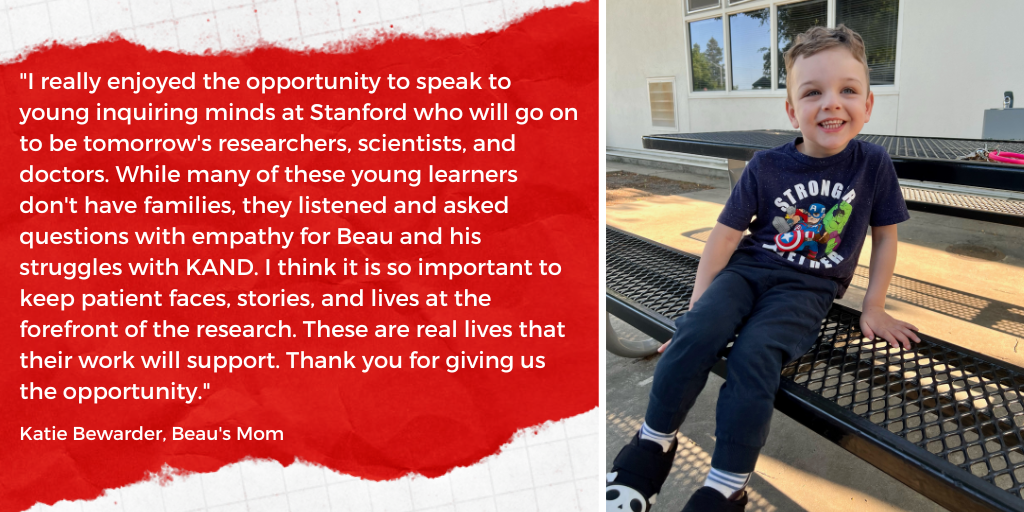
Additionally, Dr. Shi and Dr. Lessard both identified the necessity and power of bringing in KAND patient perspectives and family representatives into the classroom. Not only would this provide disease state context for the students, but it also provided a mechanism for families affected by KAND to tell their stories and be key players in the scientific process. To gather all stakeholders in the same room, Katie Bewarder and Lisa Schueneman, parents of KAND warriors Colbie and Beau (respectively), and KIF1A.ORG representatives led a session with the students of BIO 43.
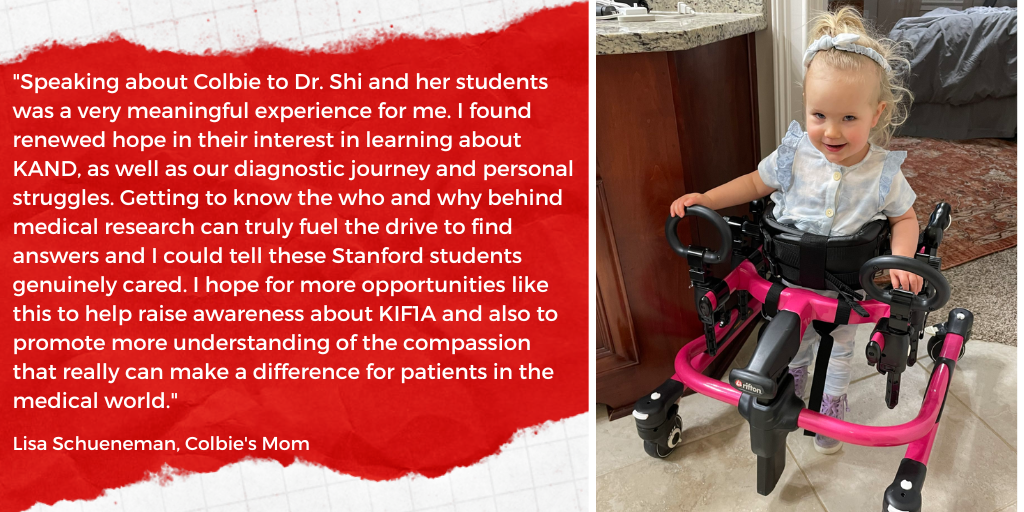
In this session, Katie and Lisa presented their experiences as parents of children affected by KAND who carry a mutation being actively investigated in Dr. Shi’s class. They both gave beautiful presentations with such grace, perfectly balancing realism and hope in their messaging as they discussed their children and the impact that KAND has had on their lives. After their presentations, parents and students came together to have an engaging question and answer session where students were able to connect with Katie and Lisa on a personal level. When the session concluded, and within the conversations that ensued afterward, it became abundantly clear that this experience had a marked impact on all involved: students, parents, and all in attendance.
To Katie and Lisa: Thank you for your openness and vulnerability in your stories and perspectives. Storytelling like yours is one of the most powerful ways to meaningfully move the needle and put patients at the forefront in the scientific sphere.
Moments Like This Matter
What is the potential impact of this exercise, and why do we need more of these opportunities in the rare disease space? Put simply, playing the long game is important especially when we take a step back to think about who we are reaching when we bring rare perspectives to a classroom of young students. These are our future doctors. Our future scientists. Our future advocates. These are students hungry for information and context to set up their future studies.
Does this approach work? Let’s ask the students themselves about their experience interacting with KAND families in the classroom:
- “I learned more deeply about the significant roadblocks and hardships these families have to go through, often because of insurance/schools/lack of understanding from their community. The resilience of these moms and families is inspiring but heartbreaking.”
- “I found that connecting our experiments and research questions to real-life situations, understanding more about the work we are/will be doing in that way, was very engaging.”
- “I think it was motivating to hear the patient stories as it’s a reminder that there are very real ramifications to our research, even if it’s just with worms.”
To the students of Dr. Shi’s class: Thank you for your engagement, compassion, and thirst for knowledge. We can’t wait to see where you all go from here and hope you will carry the rare community closely.
Integrating patient perspectives is a necessary step in our collective goal of finding rare disease treatments and cures. Starting from the very beginning, these perspectives have the ability to inform and shape the scientific method as it pertains to rare disease research. So, let’s plant the seeds early. Let’s provide opportunities and engagement for early career scientific investigators that help shape their future career decisions. And, as always, let’s put patients and their families at the center of those conversations.
